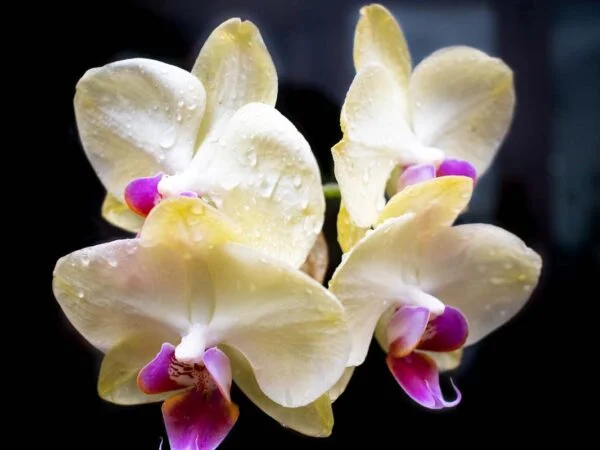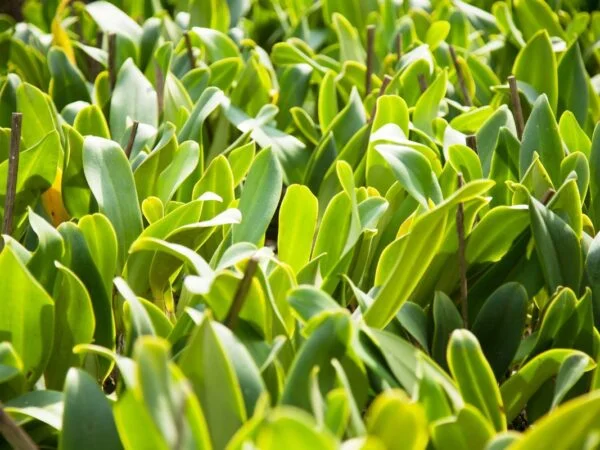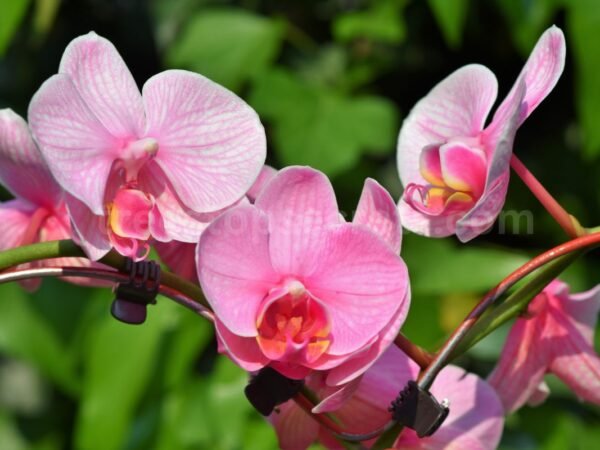Ever wondered if there's a fuss-free way to cultivate stunning orchids using pot culture and fertilizing? Imagine growing these delicate blooms without the hassle of soil and fertilizing. Can you picture it? Well, you're in for a treat! Today, we're diving into the intriguing world of water-grown orchids. From essential tips and tricks to common pitfalls, this guide has got you covered.
Are you ready to embark on an exciting journey that will unlock the secrets of nurturing flourishing orchids in water and pot culture? Whether you're a green thumb or just starting your gardening escapades, this method is perfect for anyone seeking low-maintenance yet rewarding plant care. So, buckle up and get ready to witness the magic of growing magnificent orchids in water!
Key Takeaways
-
Consider the Orchid Type: Choose orchid varieties that are suitable for water culture, such as Phalaenopsis or Oncidium, to ensure successful growth.
-
Proper Preparation is Key: Thoroughly clean and sterilize all equipment, containers, and pot culture to provide a healthy environment for your orchids to thrive in water.
-
Gradual Transition: Ease your orchids into water culture by gradually increasing their exposure to water over several weeks, allowing them to adjust without stress.
-
Optimal Light and Temperature: Position your orchids in a location with bright, indirect light and maintain consistent temperatures to support healthy growth in water.
-
Regular Monitoring and Maintenance: Monitor water levels, replace with fresh water regularly, and provide appropriate nutrients to ensure the well-being of your orchids in water culture.
-
Adapt to Challenges: Be prepared to address challenges such as root rot or algae growth by adjusting water levels, improving ventilation, or adjusting nutrient concentrations.
Orchid Water Culture
Benefits
Growing orchids in water, also known as orchid water culture, offers several benefits. This method involves growing orchids without soil, allowing the roots to absorb moisture from a water source. The practice of cultivating orchids in this manner, using water beads, has been around for centuries and is gaining popularity due to its various advantages.
Historically, the concept of water culture for orchids dates back to ancient civilizations that used this method to grow plants in areas with limited access to fertile soil. Over time, horticulturists and enthusiasts refined the technique for specific plant species like orchids. Today, it's widely recognized as an alternative way of nurturing these delicate flowers with water beads.
One advantage of orchid water culture is the reduced risk of over-fertilization. When grown in traditional potting mixtures or soils, there's a higher chance of accidentally over-fertilizing the plants. However, with water culture, this risk is minimized since nutrients can be precisely controlled and adjusted based on the needs of the plant.
Step-by-Step Guide
To successfully grow orchids using water culture at home or in a greenhouse setting requires following a step-by-step guide:
-
Increase humidity by placing containers filled with water near your orchid pots.
-
Monitor root health more easily by observing them through transparent containers or vases where they are placed.
-
Avoid over-fertilization by controlling nutrient intake through precise feeding schedules and solutions tailored for hydroponic growth mediums.
Choosing the Right Orchids
Selecting the suitable varieties is crucial for a successful venture. Not all orchids are well-suited for water culture, so choosing the right ones is essential. Some suitable varieties include epiphytic orchids that naturally grow on trees and absorb moisture from the air.
To start with, you need to select an appropriate container for water culture. The container should be transparent and have drainage holes to prevent water stagnation, which can lead to root rot. Preparing the roots for water culture involves trimming any damaged or decaying roots and ensuring they are healthy before transitioning into a water environment.
Gradually adapting the orchid to water culture is also important. This process involves acclimating the plant by initially placing it in a shallow amount of water and gradually increasing the depth over time as it adjusts to this new growing method.
Moving on, when considering orchid varieties compatible with water culture, it's important to note that epiphytic orchids are generally more adaptable due to their natural ability to absorb moisture from their surroundings. These types of orchids have evolved mechanisms that allow them to thrive in high humidity environments without needing soil.
When choosing an orchid variety for water culture, consider factors such as its natural habitat, root structure, and adaptability. Popular choices that thrive in this environment include Phalaenopsis (Moth Orchid), Oncidium (Dancing Lady Orchid), and Vanda hybrids among others due to their resilience and ability to flourish without traditional potting media.
Preparing for Water Culture
Container Selection
Choosing the right container is crucial. Not all orchids are compatible with water culture, so it's important to understand if your specific type can thrive in this environment. Factors like the structure of the roots and their ability to absorb moisture play a significant role in determining compatibility. Signs that an orchid may not be suitable for water culture include wilting leaves, root rot, and stunted growth.
The size and material of the container are also essential considerations when preparing for full water culture. The chosen container should provide ample space for the roots to grow while ensuring proper drainage to prevent waterlogging. Aesthetics can't be overlooked; selecting a visually appealing container adds an extra touch of elegance to your growing space.
Water Quality
Using filtered or distilled water is imperative when opting for pot culture with orchids. Tap water often contains minerals and chemicals that can harm delicate orchid roots over time. Testing and adjusting pH levels in the water ensures that it falls within the ideal range for optimal plant growth without causing damage or stress to the roots.
Ensuring proper drainage within the selected container prevents stagnant water, which could lead to root rot and other issues detrimental to your orchid's health. While functionality is key, considering aesthetics when choosing a container enhances not only your plant's environment but also complements its overall visual appeal.
The Transition Process
Gradual Adaptation
Before transitioning an orchid to water culture, it's essential to ensure the roots are healthy. Trimming any dead or damaged roots is crucial before making the switch. This promotes optimal growth in a water environment.
Rinsing the roots thoroughly is another vital step in this process. It helps remove any debris or old media that may hinder the transition. By ensuring clean roots, you set the stage for a successful move to water culture.
After rinsing, allowing the roots to air dry before placing them in water is important. This step ensures that excess moisture is removed and prevents potential rotting when transitioning your orchid.
Transferring Techniques
Understanding the importance of gradually transitioning an orchid to water culture cannot be overstated. Sudden changes can shock your plant and hinder its ability to thrive in its new environment.
Monitoring your orchid's response during this adaptation process is critical for success. Keep a close eye on how it reacts to being placed in water and make adjustments as needed based on its progress.
It's also important to adjust environmental conditions during this period to support successful adaptation. Factors such as light exposure, temperature, and humidity play significant roles in ensuring your orchid successfully acclimates to its new growing medium.
Setting Up Your Water Culture
Filling the Container
When transitioning an orchid to a water culture setup, it's crucial to ensure minimal disturbance to the roots. Gently remove any existing potting medium from the roots before transferring the orchid into its new water environment. This helps prevent damage and promotes a smooth transition for the plant.
Securing the orchid in its new water culture environment is essential for stability. Use suitable containers that provide ample space for root growth and stability. Ensure that the container has drainage holes to prevent waterlogging, which can lead to root rot. Choose clear containers or ones with transparent sides to allow you to monitor root health and growth easily.
Adding Water Beads
Properly filling the container with water without submerging all roots is vital in maintaining a healthy orchid in a hydroponic system. To achieve this, add just enough water so that it touches but does not submerge all of the roots. It's important to maintain an appropriate water level within the container throughout your orchid's growth cycle.
Preventing overflow or spillage when filling the container ensures cleanliness and prevents potential damage caused by excessive moisture outside of your designated growing area. Regularly check on your setup and make adjustments as necessary based on environmental conditions such as humidity levels and temperature changes.
Positioning The Orchid
Understanding how adding water beads can benefit orchids in a hydroponic system involves choosing suitable types and sizes of these beads based on your specific orchid species' needs. Different types of water beads include clay pebbles, perlite, vermiculite, or specialized gel-based products designed specifically for hydroponic systems.
Ensuring proper placement and distribution of water beads within your container supports optimal support for your orchids' roots while also promoting adequate airflow around them.
Light and Temperature Control
Ideal Lighting
When growing orchids in water, it's crucial to position the container in a spot that receives bright, indirect light. Placing the orchid near an east or west-facing window is ideal. Ensure there's enough space between multiple orchids in a shared container to prevent overcrowding. This allows each plant to receive adequate light for optimal growth.
Stabilize the orchid's position within the container by using rocks or marbles at the bottom of the vessel. This prevents the plant from toppling over and helps maintain its upright position, allowing maximum exposure to light.
Temperature Management
For orchids grown in water, it's essential to identify suitable lighting conditions for them within a hydroponic system. Natural light sources are preferable; however, if natural light is insufficient, consider using artificial grow lights designed for indoor plants.
Monitor and adjust light exposure based on how your orchid responds. If you notice wilting leaves or lack of blooming, it may indicate inadequate lighting. Conversely, if you observe yellowing leaves or signs of sunburn, reduce their exposure to direct sunlight.
Nutrient Requirements
It's crucial to establish a consistent schedule. Orchids grown hydroponically rely entirely on the nutrients present in the water, so providing them with the right balance of nutrients is essential for their growth and blooming.
Maintaining optimal temperature levels for orchids in a hydroponic system can significantly impact their overall health. These plants thrive in temperatures between 65-75°F during the day and slightly cooler at night. Understanding temperature fluctuations and their impact on orchids is vital as sudden changes can stress the plants.
Implementing heating or cooling measures may be necessary to ensure that the temperature remains within the ideal range for your orchids. For instance, using a small fan or opening windows can help lower temperatures if they rise too high, while heating mats or space heaters might be required to raise temperatures if they drop too low.
Maintaining Water Levels
Monitoring Techniques
To ensure the successful growth of orchids in water, it's crucial to explore different nutrient solutions suitable for a hydroponic system. Understanding the essential nutrients required by orchids is vital for their overall health and development. By monitoring the nutrient solution levels regularly, you can replenish them as needed to provide a conducive environment for your orchids.
For instance, if you notice that the roots of your orchid are turning brown or decaying, this could be an indication of inadequate oxygenation in the water. In such cases, adjusting the water level or aerating the solution can help address this issue. Observing any changes in leaf color or texture can also signal deficiencies in specific nutrients, prompting you to adjust the nutrient solution accordingly.
It's important to note that maintaining appropriate water levels is critical when growing orchids in a hydroponic system. Regularly assessing your plant's condition allows you to make informed decisions about adjusting nutrient concentrations and ensuring optimal root health and growth.
Water Changes
Implementing effective methods to monitor root health and growth involves paying close attention to changes in root color, firmness, and overall appearance. By observing signs of nutrient deficiencies or imbalances early on, you can take proactive measures to rectify these issues before they impact your orchid's well-being.
Regularly assessing overall plant condition includes examining not only the roots but also the leaves and stems for any visible indicators of distress or poor nutrition uptake. This holistic approach enables you to identify potential problems promptly and address them through appropriate adjustments in water levels or nutrient solutions.
Overcoming Challenges
Common Issues
Growing orchids in water can present several challenges, especially. One common issue is establishing a routine schedule for changing out the water in containers. It's crucial to ensure that the orchids receive fresh, clean water regularly to prevent stagnation and potential root rot. Another challenge is properly draining and refilling containers during water changes. This process requires careful handling to avoid damaging delicate roots or causing unnecessary stress to the plants.
Maintaining cleanliness and hygiene during water change procedures is also essential but can be challenging. Any buildup of algae or mold formation must be addressed promptly to prevent adverse effects on the orchids' health. Ensuring that the containers are thoroughly cleaned before refilling them with fresh water is vital for preventing contamination and maintaining optimal growing conditions for orchids.
Solutions and Adjustments
To address these challenges, it's important to identify common issues faced when growing orchids in a hydroponic system. For example, root rot can occur if the roots are constantly submerged without proper drainage or airflow. Algae growth may also become an issue due to prolonged exposure of the roots to light and moisture within the containers.
Addressing these issues involves seeking solutions such as adjusting watering frequency based on environmental conditions like temperature and humidity levels. Implementing measures like using opaque containers or covering them with materials that block out light can help prevent algae growth while still allowing adequate airflow.
Preventing recurring problems also requires taking proactive steps such as periodically inspecting the roots for any signs of decay or disease, as well as adjusting placement within your home environment if necessary (e.g., moving away from direct sunlight). By being vigilant about these potential challenges and making adjustments accordingly, you can create an optimal growing environment for your water-grown orchids.
Advanced Tips for Growth
Encouraging Roots
To encourage healthy root development in orchids grown in water, it's essential to address common issues such as root suffocation or stagnation. To tackle these problems, consider adjusting environmental factors like light exposure and humidity levels. For instance, if the roots appear to be suffocating due to excessive watering or poor drainage, reducing the frequency of watering can help prevent this issue.
Seeking expert advice or resources for specific challenges is also crucial. Consulting with experienced orchid growers or referring to reputable online sources can provide valuable insights into addressing root-related concerns effectively. Utilizing root stimulants or supplements can promote robust root growth in water-grown orchids.
Implementing techniques to prevent root suffocation involves using a well-draining growing medium and ensuring proper aeration around the roots. This can be achieved by choosing an appropriate container with adequate drainage holes and avoiding waterlogging that could lead to stagnant conditions detrimental to root health.
Closing Thoughts
Congratulations on making it through the essential guide to growing orchids in water! You've learned about the different types of orchids suitable for water culture, the preparation needed, and the crucial maintenance steps. By now, you should feel confident in setting up your own water culture system and providing the ideal conditions for your orchids to thrive.
Now it's time to put your newfound knowledge into action. Choose the perfect spot, gather your supplies, and embark on this exciting journey of growing beautiful, healthy orchids in water. Don't be afraid to experiment and fine-tune your approach as you go along. With patience and dedication, you'll soon be enjoying the stunning blooms and vibrant growth of your water-cultured orchids. Happy growing!
Frequently Asked Questions
How do I choose the right orchids for water culture?
Choosing orchids suited for water culture is crucial. Opt for varieties like Phalaenopsis, Oncidium, or Dendrobium that thrive in high humidity. These types are more adaptable to growing in a water-based environment, making them ideal candidates for your water culture setup.
What are the key steps in preparing orchids for water culture?
Preparing orchids for water culture involves gently removing soil from their roots and trimming away any damaged parts. Then soak the roots in room-temperature water to hydrate them before transitioning to the new growing medium. This process helps acclimate the plant to its new environment.
How can I maintain proper nutrient levels when growing orchids in water?
When cultivating orchids in a hydroponic setting, it's essential to use a balanced fertilizer specifically formulated for hydroponic systems. Regularly monitor and adjust the nutrient solution according to your specific orchid species' requirements to ensure optimal growth and development.
What challenges might arise when growing orchids in water, and how can I overcome them?
Common challenges include root rot due to overwatering or inadequate air circulation around the roots. To combat this, ensure proper drainage and aeration within your chosen container while also monitoring moisture levels closely. Maintaining consistent environmental conditions will help prevent potential issues.
Can you share some advanced tips for successfully growing orchids using a hydroponic method?
For advanced success with hydroponic orchid cultivation, consider incorporating beneficial microorganisms into your nutrient solution or utilizing specialized LED grow lights tailored to mimic natural sunlight cycles. These strategies can further enhance plant health and promote robust growth within a controlled indoor environment.
Image Source: Paid image from CANVA




